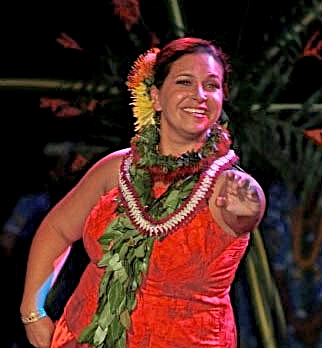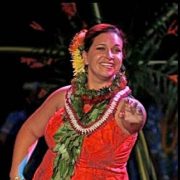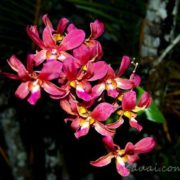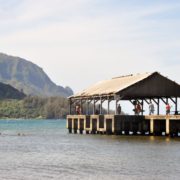Keeping Hula Alive

Kumu hula (hula instructor) Leinaa’ala Pavao Jardin dancing auana style. Photo courtesy Leina’ala Pavao Jardin
Kauai hula instructor Leinaala Pavao Jardin began dancing hula when she was three years old, continuing through high school and college, after which she began teaching. Here is an excerpt of her journey from a little girl dancing hula to becoming an instructor from the book,“Kauai Stories.”
Note: Hula, the iconic dance of the Hawaiian islands, was almost lost entirely in the 1820s when missionaries, who came to Hawaii to share their values, pushed heavily for the cultural dance to be prohibited. Hula was banned until the 1870s when laws against “public hula” were gradually lifted.
“Hula is my passion. When I dance, I feel humbled but filled with pride. We are fortunate to be able to dance hula because it was lost for so long.
In ancient times, women were totally forbidden from doing the hula. It was done only by men who would do it to prepare for battle. So a lot of the ancient hula, it’s very vigorous, like if you put a spear in their hands they could hurt someone. Eventually the men started to go off to war and that is when the women took a liking to hula. I always joke that it’s like everything in life: men started it, women learned how, we got better at it and we took over.
There are two types of hula: kahiko, the ancient, and auana, which is more modern and was developed after the missionaries arrived in Hawaii. Kahiko is very traditional; these are very old mele (songs) talking about the birth of the islands, gods and restating history.
In hula, normally if you’re writing a song about a loved one, you don’t even make mention of that loved one. You compare that person to a special flower or a special bird. Composers use the blossom as a metaphor for a loved one or a relationship. If a song is about surfing, the surfboard going in and out of the waves could be a metaphor for making love. That’s why when teaching hula, I’ve got to research the mele. You can’t just pick a song and teach it!
I want my students to feel love for the hula because you are sharing our culture. You have to put yourself in that location that the song is written about. If you’re dancing about Kokee, you better feel the chill of that mountain climate when you’re dancing so your audience can feel it.
When my niece, Jaedyn, was nine years old, I entered her in the Miss Keiki (Child) Hula competition. She was going to dance to a song named after the waterfalls in Hanapepe Valley. I wanted her to see the falls, to feel the mist on her skin.
A week before the competition, we chartered a helicopter and landed there. Jaedyn danced at the base of the waterfall and we cried and we all got wet from the spray of the falls. The next week, she won Miss Keiki Hula.”
Leina’ala Pavao Jardin will talk more about her life in hula on Saturday June 1, 2013 from 10:30 a.m. to noon at the Kauai Museum, followed by a short performance by some of her students. For more info: (808) 651-3533,




